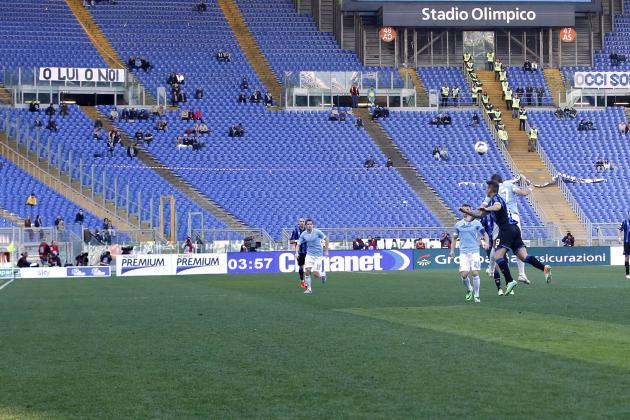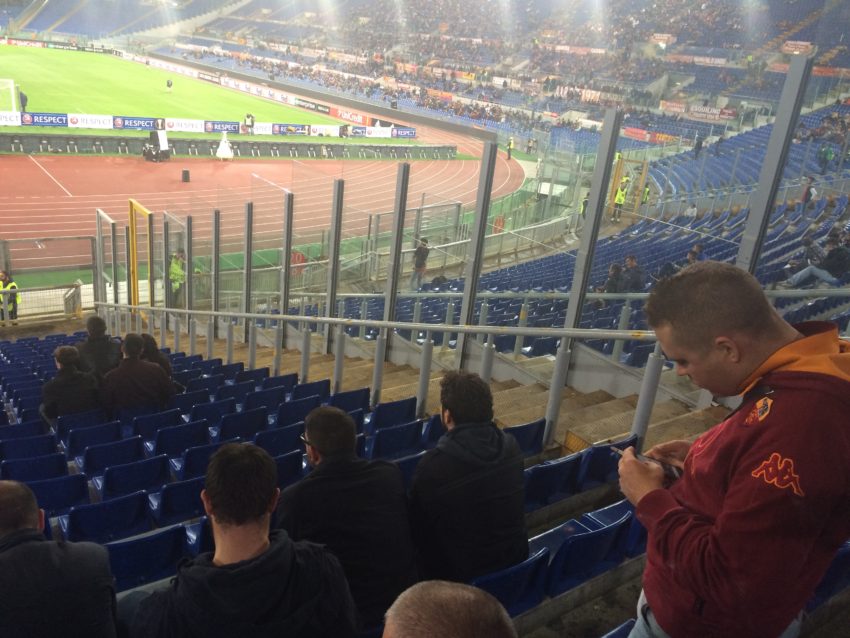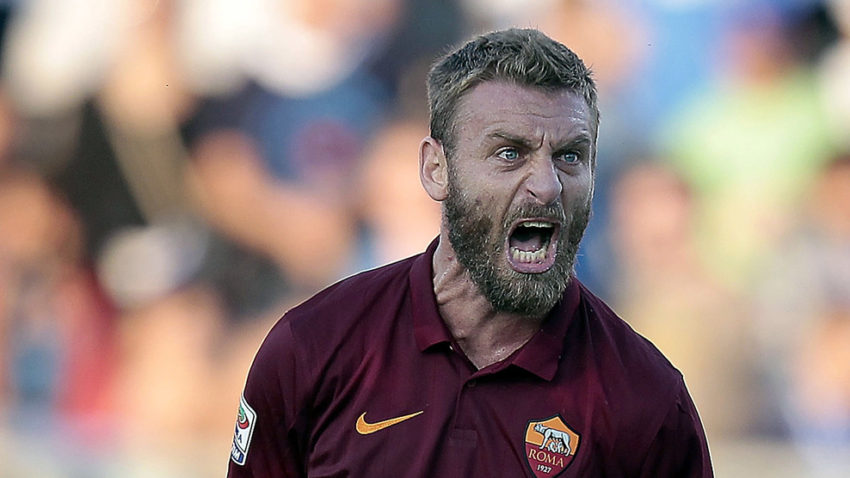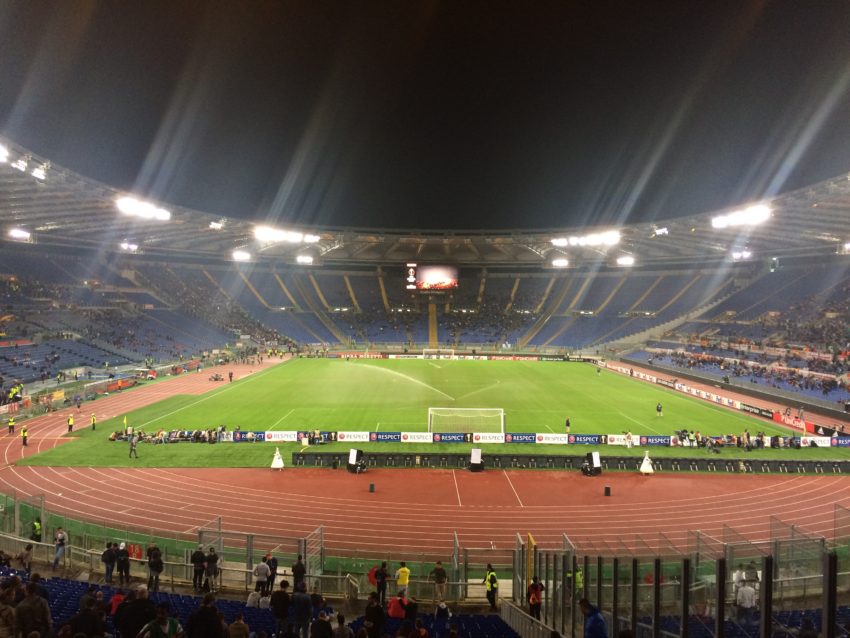Hello? Is everyone home? Soccer attendance in Italy is fading fast from fan protests, TV, economy

A.S. Roma had its highest attendance of the season Monday. And why not? Monday’s clash had all the trappings of a game for the ages. A.S. Roma versus A.C. Milan. Old rivals since the 1920s. Tied for second place. Fighting to be the top challenger of evil Juventus, the five-time defending champ which stood seven points in front of them. Italy’s two biggest cities buzzed with anticipation. National sports dailies spilled over with coverage. A boisterous crowd of 41,841 came to Olympic Stadium. It was the loudest it had been all season. Only one problem.
There were more than 30,000 empty seats.
Soccer attendance in Rome, and all over Italy, is dropping faster than Italy’s government. Nearly every team is playing in front of a half-empty stadium. League officials have termed it “embarrassing.” Players are meeting with fan groups to settle qualms.

I’m what you call around here, a romanista, a major A.S. Roma fan. It’s just as disheartening for me. My first Roma game since moving here was in January 2002. I was one of 53,422 fans to see Roma play Piacenza. Where the hell is Piacenza? It didn’t matter. Roma fans came to see their heroes who the season before won their third Serie A, or Italian league, title since their inception in 1927.
It’s 15 years later and it didn’t take me long to learn soccer in Italy is no longer what the world has read about for so many years. It only took me as long to walk through the Olympic Stadium gate one game in late October. For one, I was actually walking through the gate. I wasn’t standing in line. I was in no mob shoving to enter. I was walking through the gate for Curva Sud, the once notorious den of A.S. Roma’s vicious ultras who spent two hours every game screaming, singing insulting songs and throwing smoke bombs. In other words, they made Olympic Stadium one of the most intimidating venues in Europe. I covered the Denver Broncos for three years in old Mile High Stadium. When 65,000 fans fill Olympic Stadium, Roma’s crowd is louder. I never saw anyone at Mile High sing for four quarters.
But on this pleasant evening in Rome, Curva Sud was as mild as Sunday service. It was almost as empty, too. In a section that once filled every seat three hours before kickoff, I had empty seats to my left. I had empty seats in front of me. I saw entire sections of empty seats throughout the stadium. Only 16,478 fans rattled around the 72,698-seat stadium to watch Roma tie Austria Vienna, 3-3, in the Europa League. The Europa League is a bit like European soccer’s equivalent of college basketball’s National Invitation Tournament except it involves the entire continent. Advancing through the Europa League means a lot of money, decent prestige and a very valuable trophy to the winner. Roma was in first place in its group. But in Curva Sud, I smelled more marijuana than passion.
This season’s attendance numbers are startling. A.S. Roma’s attendance has dropped from an average of 64,271 in 2000-01 to 40,148 two seasons ago to 29,391 this season. Roma is in second place, only four points behind Juventus. Lazio, Roma’s bitter cross-town rival, is averaging only 19,625 a game, down from 47,492 in 2000-01. It’s in fifth place, eight points behind Juventus.
It’s not just in Rome. Italy’s league, Serie A, is averaging only 21,612, down from 26,519 15 years ago. The MLS (21,692) even outdrew Serie A. On the American sports radar, the MLS may be a distant fifth. In Italy, Serie A is Nos. 1, 2, 3 and 4.

The reasons range from an economic crisis to the rise of TV to stadiums nearly as old as the Colosseum. But in Rome, the biggest reason is a piece of Plexiglas about seven feet high and an inch wide.
In arguably the dumbest move the city of Rome has made since allowing Caligula to become emperor, it placed two barriers along the length of Curva Sud and Curva Nord, home of the ultras for Lazio which shares the stadium. The barriers’ purpose is allegedly to control rowdy crowds. What it really did was displace 1,000 season ticket holders and alienate two clubs’ fan bases to where they have spent the last season and a half sitting at home in protest. Never mind that the barriers don’t stop ultras from singing songs and hurling smoke bombs or that there weren’t any fights in the stands anyway. Ultras don’t fight each other. They fight other teams’ fans who have been cordoned off in their own corner of the stadium for years.
The end result is a match atmosphere that has less electricity than an EA Sports video game. I usually sit in the press tribune, a big section of tabled seats straddling midfield halfway up the stands. Olympic Stadium is so quiet I can hear coaches yelling at players. The songs are weak, like a drunk fraternity trying to serenade a sorority over Christmas.
The club had nothing to do with the decision and has met with city officials trying to find a solution. Last month, Roma stars and Rome natives Francesco Totti, Daniele De Rossi and Alessandro Florenzi, who between them have 46 years with the club, met with an ultras group of about 500. Both the ultras and city will not budge. The ultras won’t return until the barriers come down; the barriers won’t come down until the ultras show they’ll behave.
Then on Nov. 20, 2,000 ultras traveled to Bergamo north of Milan (Roma’s ultras do still travel well), threw firecrackers from the stands and fought with police outside the stadium. Three cops were injured and the league fined the club 55,000 euros. The barriers stay.
In other words, the fans blew it.
“This is not an initiative against fans,” Serie A president Maurizio Beretta said. “Dividing sectors was based on the need to guarantee greater security and that in case of incidents, only offenders are punished and not everyone else. We are very sorry for the empty areas.”
The ones who eventually lose, literally, is the club. Players say the Olympic Stadium crowd is worth about a goal a game. Considering their margin of error trying to displace the Goliath that is Juventus is as thin as that Plexiglas, the city and fans can debate who might cost Roma its fourth title in its history. Totti, 40, was on the club that won its last title in 2001. For a week the city partied in Circus Maximus, site of the ancient chariot races, and my local Piazza Santa Maria Liberatrice near where the team was born almost 90 years ago.
Totti, in his 25th season with Roma, wants one more title before he retires. He can’t do it without the fans.
“We want them back, like old times,” he said. “We need them to reach our objectives.”

Said De Rossi: “Everything has changed. The relationship with fans is different now. There are lots of barriers between us and them and the spirit is somewhat lost.”
It’s not just fans with, literally, rocket arms, who are furious. The rest of the fan base is frothing, too. The city won’t allow fans to park within two kilometers of the stadium. Why? Terrorism. You never know when one of those cars approaching the stadium will be loaded with dynamite. Rome may be the only capital city in the western world without a train line to its soccer stadium. The packed buses I take look like the last choppers out of Saigon.
Also, a new satellite system facial identifies every person entering the stadium and can link a name with anyone found committing a violation. Considering stadium security nearly conducts body cavity searches as you enter, it’s no wonder fans feel more violated.
And it’s no wonder more fans feel more comfortable sitting at home watching on TV. Subscriptions to Sky TV, which paid 600 million euros for a three-year contract, part of Serie A’s 1.1 billion TV rights, are at 4.76 million. I know. I’m one of them. Every game in Serie A is on TV. I usually watch Roma games at Abbey Theatre, Rome’s best Irish pub/sports bar where we Roma fans have our own room upstairs and waitresses wait on us hand and foot, serving us Guinness and the best fish n’ chips I’ve had outside of Liverpool.

I discussed this with my best friend, Alessandro Castellani, a Rome native, lifelong Roma fan and sportswriter for ANSA, the Italian wire service. We talked at Campo Vittorio Bachelet, the home of ASD Trastevere, Rome’s fourth-division soccer team whose attendance has doubled this season to 400 a game. It’s not just because the club’s in first place and the quaint, leafy field puts fans atop the players. Many in Rome are fed up with the political climate and hassles of 56-year-old Olympic Stadium.
“There is too much soccer on TV,” Castellani told me. “In England they don’t show all the games. They should do the same here. They should only show it in Rome if it’s sold out. If they know they can’t see it on TV, people will go.”
My Sky subscription costs 22 euros a month. The average price of an AS Roma ticket is about 40. You do the math. I’m retired. Imagine a Roman family going to a game during Italy’s biggest economic recession since World War II.
“And don’t forget how strong Sky TV is,” said Turin native Massimo Franchi of the national sports newspaper, Tuttosport, and a sportswriter in Italy for 38 years. “It’s better than going to the stadium. You go to the stadium it’s 5 degrees (celsius). At night it’s 1 to 3. An hour and a half before the match, you drink a coffee, a whiskey, a Coca-Cola. You can look at your idols in the dressing room and see an interview with (Juve goalie Gianluigi) Buffon or (A.C. Milan owner Silvio) Berlusconi about the match. You can see the match in 90 minutes then for one hour they’re in the studio.”
On Dec. 4 came the derby, the rivalry between Rome and Lazio, which the media billed as one of the biggest games in their savage 90-year history. Roma (9 wins, 2 ties, 3 defeats) was in second place with 29 points; Lazio (8-4-2) was fourth with 28. Roma’s 33 goals were the third most in Europe behind only Monaco (44) and Real Madrid (36). Only Barcelona’s Lionel Messi and Paris Saint-Germain’s Edinson Cavani, both with 19, had more goals than Roma’s Edin Dzeko’s 17. Lazio was one of only five teams in Europe unbeaten in its last nine games and was off to its best start since 2003-04. This is Roma’s most potent offense since 1934-35.
The crowd was 41,841. Lazio’s ultras returned for the game; Roma’s did not. Roma won, 2-0. Roma beat Milan, 1-0. Roma plays at Juventus Saturday night. Meanwhile, the club and city continue their fight over a projected 1.5 billion euro, 52,500-seat stadium on the southwest edge of Rome.
No word on whether it will have barriers.

